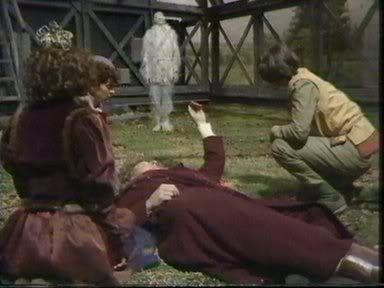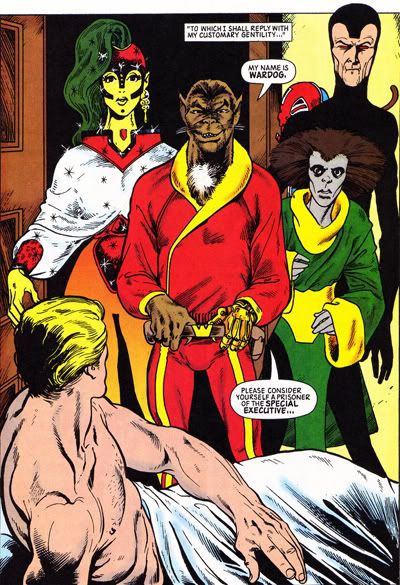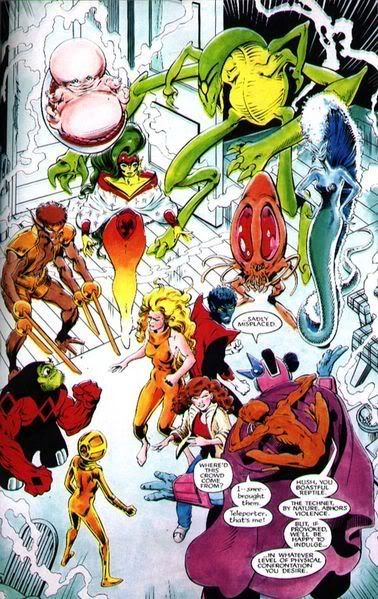According to the Online Etymology Dictionary the term "Doctor" entered common English usage in the early 14th century as a term for Church Fathers. The Latin term means teacher, which evolved into "religious teacher, adviser, scholar". The doct- derives from docere, "show, teach, make to appear right". In the late 14th century it became the term for the holder of the highest degree of a University and as such the term for a medicinal practitioner. The verb form, "to alter, disguise or falsify" developed late in the 18th century.
The alchemist/philosopher/theologian Raymond Lully was nicknamed Doctor Illuminatus by Duns Scotus, another important philosopher/theologian of the High Middle Ages. Scotus' code name was Doctor Subtilis for the subtle, penetrating, sophisticated manner of his reasoning.
High fantasy fictions (such as super hero comic books) are full of enlightening characters whose codenames utilize the term Doctor. And what better descriptor could there be for a degree holder and teacher of the Invisible College? I've broached the subject of the Invisible College before in my article Mercury Retrograde, and as I stated at that time, the Wikipedia description just scratches the surface of this conceptual entity. But that does not mean their description is not of interest, as is the case when Wikipedia states:
"The idea of an invisible college became influential in seventeenth century Europe, in particular, in the form of a network of savants or intellectuals exchanging ideas (by post, as it would have been understood at the time). This is an alternative model to that of the learned journal, dominant in the nineteenth century. The invisible college idea is exemplified by the network of astronomers, professors, mathematicians, and natural philosophers in 16th century Europe. Men such as Johannes Kepler, Georg Joachim Rheticus, John Dee and Tycho Brahe passed information and ideas to each other in an invisible college. One of the most common methods used to communicate was through annotations written in personal copies of books that were loaned, given, or sold from person to person".
A primary method for initiates of an Invisible College to communicate is through the use of an argotic system of symbolism, which the enigmatic 19th century alchemist Fulcanelli termed the Language of the Birds or Green Language. Fulcanelli, it should be noted, is the pseudonym of an unknown individual or individuals. The name means "Little Vulcan" and he could properly be termed Doctor Vulcan. The more common English term for argotic language is Cant which demonstrates clearly the mystical nature of a cryptolect.
Then there is Doctor John Dee, one of the most influential minds of all time. That's not hyperbole, it is more likely an understatement. Dee is closely associated to the most visible manifestation of the ancient Invisible College as described in the Wikipedia article. The surname Dee is derived from the Welsh "du" meaning black. Doctor Dee is Doctor Du is Doctor Black is Doctor Dark.
Above and beyond all the many intellectual caps Dr. Dee wore in his lifetime was his role as a Hermeticist, an occult philosophical and alchemical movement based upon the teachings of the legendary Hermes Trismegistus. Trismegistus means "Thrice Gifted" and he could just as well be called Doctor Trivia. The term Trivia derives from the Latin Trivium, which is the "place where three roads meet". These crossroads were dedicated to the Messenger god Hermes/Mercury/Thoth since ancient antiquity. Hermes Trismegistus is the legendary initiator of the occult science and philosophy that informs Doctor Dee, and as such can be viewed as the fountain head of the Underground information Stream termed the Invisible College.
Now it is my contention that super hero comic books and other forms of high fantasy fiction serve as the perfect vehicles for communication of argotic symbolism. High fantasy fiction is Romantic, it is Art Gothic, which Fulcanelli tells us is itself an inter-lingual phonetic punning term. Art Gothic is the Art Goetic and the Cant Argotic. The initiates who navigate this information stream are Argonauts. The masthead of the Argo was Athena. This is not to state that comic book creators and other fantacists purposefully embed secret symbols in their works (though some may). The beauty of the Language of the Birds lies in its subtle function, its subconscious expression, and its synchronistic manifestation.
The many Doctors and Professors of high fantasy fiction are symbolic representatives for the teachings of the ancient, prehistoric Invisible College. So should I approach this accounting chronologically? No, that would likely be impossible. At any rate, many of these illuminated Doctors defy chronology on a regular basis, sometimes as their raison d'etre. So in this article let's focus on the character who most connects the symbolic model of the Doctor as an entity beyond Time and Space. I speak of course of the protagonist and near title character of "Doctor Who", The Doctor.
I'm not nearly the Whovian I'd like to be, but I love Doctor Who. Clearly it is one of the most pertinent science fiction classics of all time. Doctor Who manages to connect to just about everything, I suppose a natural given the qualities of the character and the subject matter of the program. I'm still so amazed by the fact that Doctor Who premiered on the day John F. Kennedy died. I do feel it is worth noting the synchronicity of these events. The sacrifice of the Sun King JFK is near coincident with the opening of this corridor through Space/Time which millions of viewers have been exploring for nearly 45 years. Yes it is a fantasy, an allegory, a metaphor. But though a symbol, while abstract, it is still a portal to the most immediate Other World available to us, the Dream Time. And Who is our guide for this journey in between days. That's a statement.
The BBC program "Doctor Who" is more than just a science fiction program. It is an institution and has developed as an emblem in modern British culture. It is the Guiness World Record holder for longest running science fiction television program. The character of The Doctor has become a world-wide cultural icon, as has his time machine The TARDIS and his most prominent antagonists, the exterminating Daleks.
Amongst the most interesting characteristics of the time and space traveling Doctor is his and other Time Lords ability to regenerate. A Time Lord who suffers a mortal wound or whose physical body wears out from advance age undergoes a "genetic reshuffling" and incarnates in a new physical form that differs not just in physical appearance but in personality and characteristics as well.
This is a very interesting element of the show for a number of reasons. It is a great example of how commercial or programming concerns can incidentally derive storytelling elements with intriguing symbolic significance. The regeneration ability was not introduced to the "Doctor Who" program until it was necessary. When the original Doctor portrayer William Hartnell left the program in 1966 the producers faced the prospect of ending the series or finding another actor to portray the lead role. Rather then just ignoring the fact that the Doctor now looked and behaved differently the show's creators took advantage of their time-bending subject matter and introduced the element of Regeneration.
And so developed one of the most profound symbolic aspects of the program. The Time Lords are described as being limited to twelve reincarnations for a total of thirteen lives (though certain Time Lords have been shown to have found ways to exceed this limitation, such as the Doctor's archnemesis The Master). The significance of twelve reincarnations leading to thirteen lives is clear, the zodiacal twelve represents a complete cycle, the thirteenth life takes things full circle. Thus far the Doctor has been seen to have had ten official incarnations.

The Ten Doctors, clockwise begining at upper left: William Hartnell, Patrick Troughton, Jon Pertwee, Tom Baker, Peter Davison, Colin Baker, Sylvester McCoy, Paul McGann, Christopher Eccleston, and David Tennant.
It is suggested at several points throughout the series that the Doctor and other Time Lords are transcendent beings, entities existing in someway on a higher temporal plane manifesting in our dimension in a corporeal form. One example of this comes during the end of the Doctor's Fourth incarnation when he encounters and is assisted by a featureless, white clad entity known as The Watcher. When the Doctor begins his regeneration into his Fifth form he and the Watcher merge.

During the Doctor's Seventh incarnation he appears to share many traits with his previous lives such as the whimsy of the Second and Fourth Doctors and the scientific brilliance of the First and Third. But as the storyline of the Seventh Doctor developed it could be seen that beneath the surface he was an entity akin to a demigod, dedicated to destroying evil at all costs. Indeed I think it is quite clear that the Time Lords are a sort of science fiction angel, not unlike the Ainu of Tolkien's Middle Earth mythology. Further, the Doctor is a rebel Time Lord with a pronounced sense of justice which causes him to disregard Time Lord policies and take direct action with time and space for the benefit of humankind and other sentient lifeforms. This clearly makes the Doctor a Promethean figure. According to the Master, the Doctor took on his pseudonym (his true name has never been revealed) to denote himself as "the man who makes people better".
The Doctor's time machine, the TARDIS (Time And Relative Dimension In Space) is said to locked in its iconic shape of a Blue British police box due to a faulty Chameleon Circuit. The phone booth sized exterior opens to a labyrinth complex because a TARDIS is "dimensionally transcendent", its interior occupying a pocket dimension separate from the exterior. Interestingly, one of the elements the TARDIS needs to function is mercury. True Whovians should check out the fan made "TARDIS Manual" by A. B. Roberts.
As stated near the beginning of this article, Doctor Who manages to connect to a wide array of diverse cultural elements. Within the context of the story, for example, is a future or alternate reality version of the Doctor who goes by the name Merlin. As for the program itself, past episode writers for the series include author Douglas Adams who not only brought us the life, the universe and everything solving "Hitchhiker's Guide to the Galaxy" series but also "Dirk Gently's Holistic Detective Agency" and its sequel "The Long, Dark Tea-Time of the Soul". Not very weird considering the nature of Adams' reality bending works, right? Well then, how about Henry Lincoln? Lincoln is perhaps best known as coauthor of "Holy Blood, Holy Grail"* and he continues to investigate the mysteries of Rennes-le-Chateau to this day.
Then there is the Doctor's slim but existent connection to the universe of Marvel Comics. As one would expect with a program with the longevity and level of fandom of "Doctor Who" there arose many spin-offs and presentations in other media including numerous novels, radio programs and "Doctor Who Magazine". The magazine, still in publication, began in 1979 as "Doctor Who Weekly" and was initially published by Marvel UK. Included in the magazine's features were short comic book adventures. Amongst the creators of the Doctor's comics were Alan Moore and Dave Gibbons the writer/artist team who brought us "Watchmen". Another artist on "Doctor Who Weekly" was David Lloyd, who was also the artist on Moore's "V for Vendetta".
Lloyd was working on the Doctor Who comics with Moore when the Special Executive was introduced. The Special Executive is a band of time-traveling mercenaries, and several members of the group are native to the Doctor's home planet of Gallifrey. Later Alan Moore worked on Marvel UK's Captain Britain serial with illustrator Alan Davis (the two Alans would collaborate again on Marvelman/Miracleman), and Moore reintroduced the Special Executive to Captain Britain's adventures.

Art by Alan Davis
Moore came to grow dissatisfied (quite rightly) with Marvel's treatment of creative talent, ceased working for the company and refused permission for them to utilize the Special Executive. So Alan Davis then developed the similar and related band known as the Technet for use in the Captain Britain stories. Later Alan Davis teamed with long-time X-Men writer Chris Claremont on the X-Men spin-off "Excalibur" with a team that included Captain Britain. The Technet followed the Captain to the title.

Art by Alan Davis
This creates an interesting phenomenon that is again the result of commercial decisions and concerns. More than once Marvel has done adaptations such as "Doctor Who" and allowed the characters and concepts to coexist in the shared universe of their super hero titles. This plastic feature of Marvel comes up in "Doctoring Art Gotic" Part II where I'll examine some of the Doctors and Professors of the Marvel Universe.
Want one more wild Doctor Who connection before we close Part I? In 1988 "The Illuminatus! Trilogy" inspired, discordian acid house band The KLF (aka the JAMs, the Justified Ancients of Mu Mu), under the name The Timelords released "Doctorin' the Tardis", combining Dalek voice overs with the Doctor Who theme and Gary Glitter's "Rock and Roll(Part Two)". It reached #1 on the UK charts:
Note, this is not the original video, but a fan creation utilizing clips from recent seasons of "Doctor Who". Any nostalgic fans of really low-budget discordian absurdism can see the original here.
And things just aren't complete without a Dog around lately. If you watched the video you may have spotted the Doctor's longest running companion, the robotic K-9. Because travelers should have a Dog, just ask Dorothy Gale.

*You may have already heard that "Holy Blood, Holy Grail" coauthor Richard Leigh passed away on November 21st of this year at the age of 64 due to complications of a heart condition.
No comments:
Post a Comment